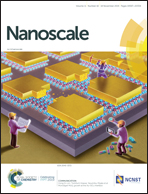Apoptotic lysosomal proton sponge effect in tumor tissue by cationic gold nanorods†
Abstract
Despite the lysosomal “proton sponge hypothesis” being considered to be an additional factor for stimulating the cellular toxicity of nanoparticle-based drug delivery systems, a clear relationship between the massive influx of calcium ions and the proton sponge effect, both of which are associated with cancer cell apoptosis, has still not been elucidated. Cetrimonium bromide (CTAB: cationic quaternary amino group based) gold nanorods possessed a more effective electric surface charge for inducing the lysosomal proton sponge effect than anionic gold nanoparticles. In this aspect, identifying released cytoplasmic Cl−, arising from the ruptured lysosomal compartment, in the cytoplasm is critical for supporting the “proton sponge hypothesis”. This study clarified that the burst release of Cl−, as a result of lysosomal swelling by CTAB gold nanorods, stimulates the transient receptor potential channels melastatin 2 (TRPM2) channels, and subsequently induces a massive Ca2+ influx, which independently increases apoptosis of cancer cells. Although the previous concept of elevated cancer apoptosis acting through the proton sponge effect is unclear, this study supports the evidence that a massive Ca2+ influx mediated in response to a burst release of Cl− significantly influenced cytotoxicity of cancer cells in tumor tissues.



 Please wait while we load your content...
Please wait while we load your content...